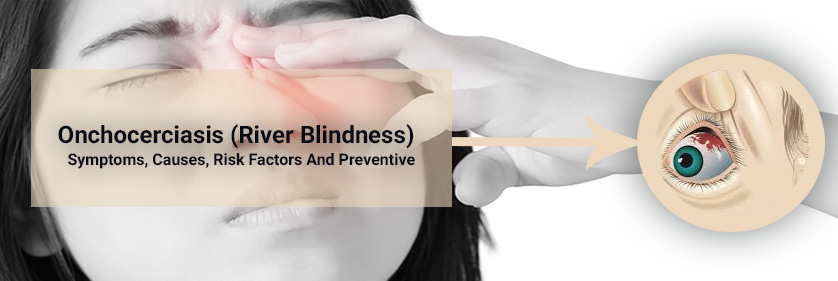Onchocerciasis, also called River Blindness, is a condition which affects the skin and eyes. It is caused by the volvulus Onchocerca worm.
Onchocerca volvulus is a parasite. It’s spread to humans and livestock through the bite of a type of blackfly from the genus Simulium. This type of blackfly is found near rivers and streams. That’s where the name “river blindness†comes from.
Symptoms
Not everyone with onchocerciasis will have symptoms, especially not right away. Most new infections won’t start to show any symptoms for a year or two, and those with mild cases might never even know they’ve been infected with the parasite. While the most well-known symptom of onchocerciasis is blindness (thus the nickname), the disease affects both the skin and the eyes and can cause a range of symptoms, from irksome to disfiguring.
Symptoms Include:
- Nodules under the skin where the adult worms are
- Intense itchiness
- Swelling
- Changes in the skin, sometimes called “leopard†or “lizard†skin
- Lesions on the eye
- Altered vision
- Blindness
It’s important to note that it often takes more than one blackfly bite to get infected with onchocerciasis. Usually, the most severe and crippling outcomes associated with the disease occur after years of prolonged parasite exposure. The more infections a person experiences throughout their lifetime, the more likely the damage done to the eyes and skin becomes permanent or leads to blindness and disfigurement.
What causes Onchocerciasis?
The cause of onchocerciasis is the transfer of the Onchocerca volvulus parasite larvae by the female blackfly when a human is given a blood meal (bites) by the fly. The larvae enter the subcutaneous tissue and evolve into male and female adult worms (filarial nematodes). These reproduce in the human tissue and form microfilariae which migrate to other areas of the connective tissue and occasionally to blood, urine and sputum. Additionally, both adult worms and microfilaria are colonized with so-called Wolbachia bacteria that help survive these parasites. When the worms die, an immune response from the host ensues that optical tissue in the eye may be damaged. The parasite life cycle continues when a blackfly bites a human and ingests microfilariae during his blood meal.
What are the risk factors for onchocerciasis?
Living in and visiting sub-Saharan Africa and a few other areas where blackfly is endemic is a major risk factor for developing onchocerciasis. The disease usually occurs after repeated exposure to blackfly bites, so there is little risk for short-term travellers in these areas; however, missionaries, volunteer health workers and others who may spend a few months in areas have increased risk of infection.
Complications
The nodding disease has been associated with onchocerciasis which is a rare type of epilepsy. It is relatively rare and affects about 10,000 children in eastern Africa. Trials are being conducted to learn whether or not doxycycline could help reduce the neuroinflammation that occurs.
Preventive Methods
The most serious symptoms of river blindness arise from repeated parasite exposure. This is why preventing future infections is an important part of treatment. There’s no vaccine or drug that can prevent an onchocerciasis infection, but there are things you and whole communities can do to lower the odds of getting one.
- Personal Protection: Because no vaccine or effective chemoprophylaxis is available to prevent onchocerciasis, one method used to reduce the chance of infection is to take basic measures to avoid getting bitten by the black fly. These measures include avoiding the black fly habitat, using insecticides like DEET, wearing long pants and sleeves, and putting insect netting around where one sleeps. These methods are fairly effective for travellers, but less effective for people who live in endemic areas.
- Vector Control: One step countries take to reduce the number of river blindness cases is by removing its vector: the black fly. Without the help of blackflies, the parasite cannot spread within a community. Sprinkling the breeding sites of the flies with insecticide can disrupt the parasite’s life cycle and stop new infections from occurring in the area.
- Mass Treatment Programs: Another way areas work to prevent the parasite from spreading is by aggressive care with ivermectin for all in a given population, regardless of whether they have been diagnosed with the parasite. This not only helps to treat light infections that may not have been detected with diagnostic tests but also disrupts the parasite’s life cycle. Blackflies spread the larvae from person to person (not the adult worms), so by treating everyone in the area to kill the larvae, the blackflies don’t have anything to go through, and communities can stop new infections for a while.

Leave a Reply
You must be logged in to post a comment.